#Moritze Meurer
Explore tagged Tumblr posts
Text







“I...go on my bicycle or by train
out into the environs of Berlin.
And if...I find an interesting
plant...then I am obliged for the
next three or four months to make
virtually daily expeditions to
that spot in order to search again
and again for that same plant.”
Karl Blossfeldt
Karl Blossfeldt (1865 - 1932) was a German photographer, sculptor, teacher, and artist who worked in Berlin, Germany. He is best known for his close-up photographs of plants and living things, published in 1929 as Urformen der Kunst.
Born in Schiele, Harz, Germany, he worked as an apprentice in an artistic form of iron casting at the iron foundry in Mägdesprung between 1881 and 1883 and studied art at the Institute of Royal Arts and Museum (later named College of Fine Arts, or Hochschule für Bildende Künste) in Berlin between 1884 and 1890. In 1890-1896 he participated in a project in Italy, run by Moritz Meurer, collecting plant material for drawing classes. During this period Blossfeldt started systematically documenting plant samples photographically. Some of his photographs appear in Meurer’s publications at the turn of the century. He started teaching at the Institute of Royal Arts and Crafts Museum in Berlin in 1898, and continued working there as a professor from 1921 until 1930. His first exhibition was held in 1926 at the Nierendorf Gallery in Berlin; and published the book Urformen der Kunst.
21 notes
·
View notes
Text
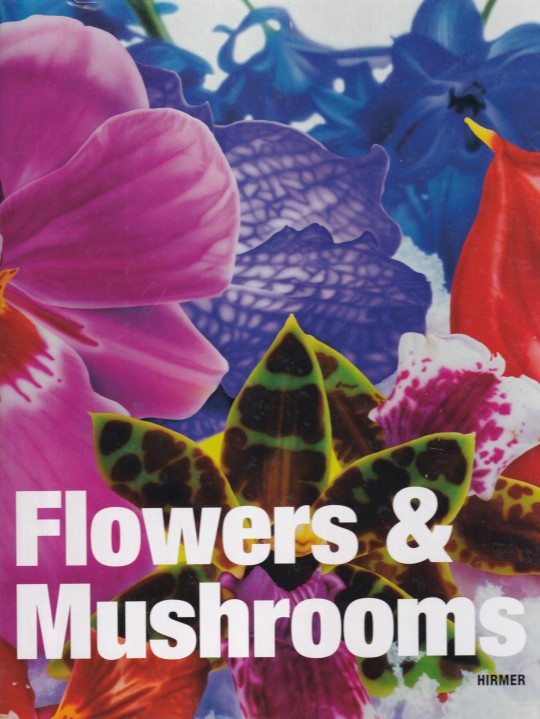


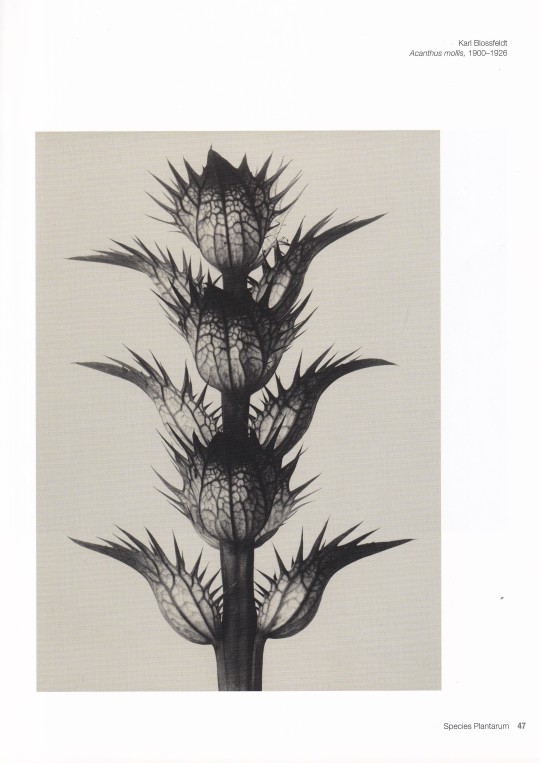



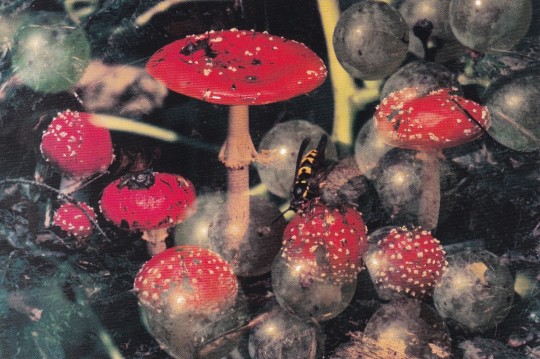
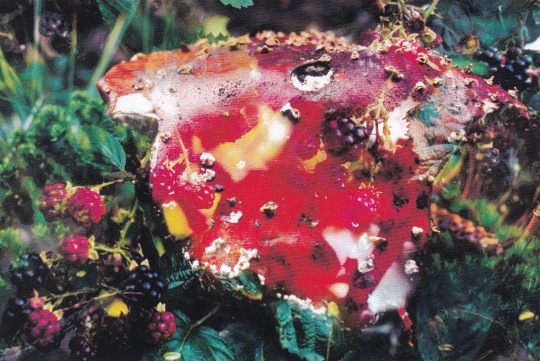

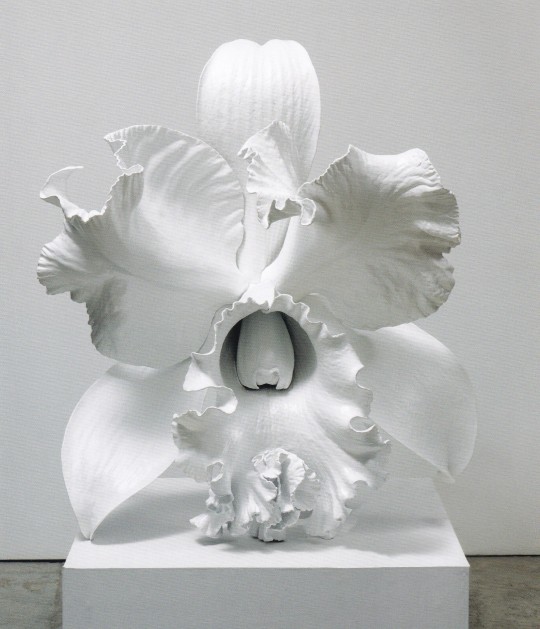

Flowers & Mushrooms
Essays by M. Harder, M. Moschik, T. Teufel, P. Weiermair, V. Ziegelmaier et al.
Hirmer Verlag, München 2013, 256 pages, 24x28,5cm, ISBN 9783777421605
euro 40,00
email if you want to buy [email protected]
Flowers and Mushrooms takes readers inside the rich and diverse symbolism of its eponymous subjects. Flowers have at times stood for freshness and fertility, transience and death. In addition to its ubiquitous and much-maligned image as a hallucinogen, the mushroom has throughout history signified health and life and served as an important symbol within religious ritual. In recent years though, flowers and mushrooms have become a focus in contemporary art, with artists manipulating the many clichés that surround them and adapting their representation to produce new and unexpected layers of meaning, from social criticism to feminism and the conceptual framework of the erotic. Among the leading plant portraitists are the Swiss duo Peter Fischli and David Weiss, whose series of forty photographs epitomize the potential to shed new light on familiar objects by presenting them in unusual context.
The exhibition at MdM Museum der Moderne - Salzburg presents works from Nobuyoshi Araki, Anna Atkins, Eliška Bartek, Christopher Beane, Karl Blossfeldt, Lou Bonin-Tchimoukoff, Balthasar Burkhard, Giovanni Gastel, Georgia Creimer, Imogen Cunningham, Nathalie Djurberg, Hans-Peter Feldmann, Peter Fischli/David Weiss, Sylvie Fleury, Seiichi Furuya, Ernst Haas, Carsten Höller, Judith Huemer, Dieter Huber, Rolf Koppel, August Kotzsch, David LaChapelle, Edwin Hale Lincoln, Chen Lingyang, Vera Lutter, Katharina Malli, Robert Mapplethorpe, Elfriede Mejchar, Moritz Meurer, Paloma Navares, Nam June Paik, Marc Quinn, Albert Renger-Patzsch, Zeger Reyers, Pipilotti Rist, August Sander, Gitte Schäfer, Shirana Shahbazi, Luzia Simons, Thomas Stimm, Robert von Stockert, William Henry Fox Talbot, Diana Thater, Stefan Waibel, Xiao Hui Wang, Andy Warhol, Alois Auer von Welsbach, Michael Wesely, Manfred Willmann, Andrew Zuckerman.
07/03/24
#Flowers & Mushrooms#exhibition catalogue#MdM Museum der Moderne - Salzburg 2013#Araki#Blossfedt#Gastel#Fischli/Weiss#LaChapelle#Mapplethorpe#Sander#Warhol#Haas#Nam Jun Paik#photography books#fashionbooksmilano
13 notes
·
View notes
Photo
" I…go on my bicycle or by train out into the environs of Berlin. And if…I find an interesting plant…then I am obliged for the next three or four months to make virtually daily expeditions to that spot in order to search again and again for that same plant. " ─ Karl Blossfeldt (German, 1865-1932)
He is best known for his close-up photographs of plants and living things, published in 1929 as Urformen der Kunst. He was inspired, as was his father, by nature and the ways in which plants grow.
Blossfeldt’s photography career began when he was photographing botanical specimens for Moritz Meurer. Blossfeldt later continued to develop his skillset, and his collection of photographs, while he was working as a professor. The photographs he took for Moritz Meurer and during his teaching years were used as reference photographs for his personal work and for his teaching purposes. He kept a detailed log of the common and scientific names of every specimen that he photographed, and eventually produced roughly 6,000 photographs.
It wasn't until Blossfeldt was in his 60s that his photographs began to receive recognition for their artistic value, as opposed to their functionality as references. This recognition began in 1925 when art gallerist Karl Neirendorf first began representing Blossfeldt. With the help of Niernedorf, Blossfeldt's first monograph Urformen der Kunst was published in 1928. Urformen der Kunst gained overnight success and recognition. This segued into Blossfedlt's rise in fame that eventually lead to his second publication Wundergarten der Natur. Despite Blossfeldt's lack of professional training his work as a photographer, photography is what he is best known for.
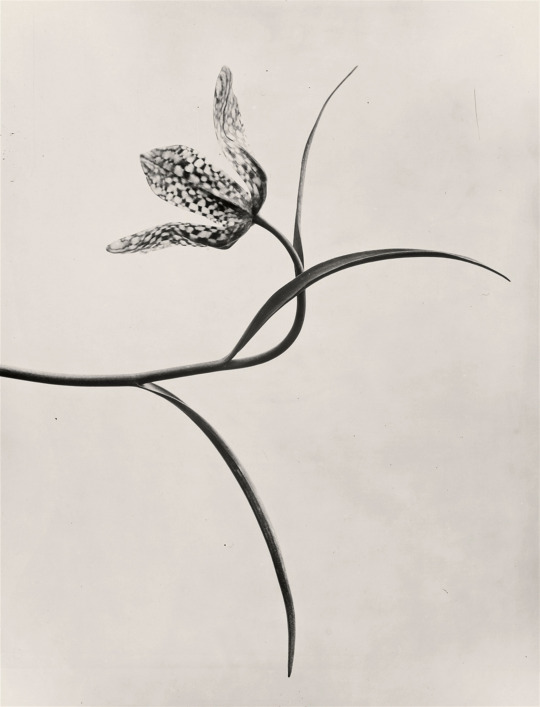
Pflanzenformen, Photo by Karl Blossfeldt, 1920s
1K notes
·
View notes
Photo

Perseus freeing Andromeda, attributed to Moritze Meurer.
1 note
·
View note
Photo

Pflanzenformen: vorbildliche Beispiele zur Einführung in das ornamentale Studium der Pflanze - Moritz Meurer - 1895 - via University of Heidelberg
667 notes
·
View notes
Photo










CLAWMARKS
Pflanzenformen: vorbildliche Beispiele zur Einführung in das ornamentale Studium der Pflanze - Moritz Meurer - 1895 - via University of Heidelberg
Esemplare del disegno in gratia dei principianti nell 'arte della pitura and scultura - 17th c. - via Internet Archive
C. McKnight-Smith illustration (after Chas R. Knight) - Scientific American - vol. 94, no. 5 - February 1906 - via Internet Archive
Charles Frederick Holder - Half hours with fishes, reptiles, and birds - 1906 - via Internet Archive
Six Studies of Pillows - Albrecht Dürer - 1493 - via The Met
The fly agaric fungus (Amanita muscaria): two fruiting bodies - 1892 - via Wellcome (edited)
Elf grote en kleine tropische kaurie schelpen - Johann Gustav Hoch - c.1726-1779 - via Rijksmuseum
Iconographia Cactacearum vol. 2 - 1921 - via Technische Universität Berlin
Nudibranchia - Ernst Haeckel - 1904 - via LOC
Gems from cutter to you : also mountings direct from the jeweler’s bench ; the only mail order lapidaries in the world - Esterlin, Moser & Co. - 1911 - via Internet Archive
4 notes
·
View notes
Quote
Die Pflanzenfotografien Karl Blossfeldts sind heute weltweit berühmt. Fast unbekannt ist, dass ihre Entstehungsgeschichte einen Teil der Geschichte des Berliner Kunstgewerbemuseums bildet: Nicht als freie Kunstfotografien fertigte Blossfeldt sie an, sondern als Elemente einer Lehrmittelsammlung, mit der der Lehrer Moritz Meurer (1839–1916) in den 1890er Jahren das Pflanzenstudium an der dem Kunstgewerbemuseum angeschlossenen Kunstgewerbeschule in den Fokus rückte. Anhand von Modellen, Herbarien, Lehrtafeln und Fotografien sollten die Gesetze natürlicher Formbildung durchdrungen und die Gestaltungslehre erneuert werden.
Ausstellung Form Follows Flower Moritz Meurer, Karl Blossfeldt und Co., Kunstgewerbemuseum Berlin 2017/2018
0 notes
Text




For my Portfolio Proposal, I choose to portray the transition from one season to the next as the seasons change. Spring represents the beginning of something new and the turning of a new leaf. I decided to use a leaf/flower as my subject in my photographs, as well as water, to reflect the changing of the seasons, more like botanical photography. Spring is a time to meet new people and do new things, to discover yourself and change into a new person. Spring is a time for taking chances and overcoming fears, as well as for growth and transformation. Spring marks the end of an era and the beginning of a new one. The type of photography that interests me the most, I would say, is Still Life. This type of photography in which immovable subject matter, usually a small group of objects, is represented. It is the introduction of photography to the still life artistic approach, like still life painting.
I will be taking landscape images for a botanical style photograph, like how Karl Blossfeldt and Vincent van Gogh have at their times. From 1884 until 1890, Karl Blossfeldt worked as a sculptor, completing apprenticeships at the ironworks and foundry in Mägdesprung and the Kunstgewerbeschule (Institute of the Royal Arts Museum) in Berlin. (“Karl Blossfeldt | MoMA”) Working with Moritz Meurer, who believed that natural shapes were recreated in art, he went across Italy, Greece, and North Africa from 1890 to 1896. Blossfeldt taught at Berlin's Kunstgewerbeschule from 1898 to 1930, building a collection of thousands of images of plants that he used as models to instruct his students. Vincent van Gogh, full name Vincent Willem van Gogh, was a Dutch painter who lived from March 30, 1853, in Zundert, Netherlands, to July 29, 1890, in Auvers-sur-Oise, near Paris, France. (“33+ vincent willem van gogh paintings - UdelFestia”) He is widely considered the greatest painter after Rembrandt van Rijn and one of the greatest post-Impressionists. His story's bold colour, strong brushwork, and curved forms strongly impacted the modern art current of Expressionism. After his death, Van Gogh's art became incredibly popular, especially in the 1990s, when his work sold for record-breaking sums at auctions across the world and was featured in massive travelling exhibitions. (“Vincent van Gogh · English reading exercise (advanced level) | bitgab”) Van Gogh has been lost to history in the popular imagination as the ideal suffering artist, thanks in part to his numerous published writings.
Finally, I choose to portray the transition from one season to the next as the seasons change for my Portfolio Proposal. To symbolize the shifting of the seasons, I decided to use a leaf/flower as my subject in my shots, as well as water, to make it more like botanical photography. I'll be photographing landscapes for a botanical style photograph, like what Karl Blossfeldt and Vincent van Gogh did in their respective eras.
Work cited:
“Karl Blossfeldt: Moma.” The Museum of Modern Art, https://www.moma.org/artists/24413.
“Vincent Van Gogh.” Encyclopædia Britannica, Encyclopædia Britannica, Inc., https://www.britannica.com/biography/Vincent-van-Gogh.
“Vincent Van Gogh.” Van Gogh Museum, https://www.vangoghmuseum.nl/en/art-and-stories/art/vincent-van-gogh.
Picture 1 : “Karl Blossfeldt. Hordeum Distichum. 1898–1932: Moma.” The Museum of Modern Art, https://www.moma.org/collection/works/83719?artist_id=24413&page=1&sov_referrer=artist.
Picture 2: “Vincent Van Gogh - Sunflowers.” Van Gogh Museum, https://www.vangoghmuseum.nl/en/collection/s0031V1962.
Picture 3 : “Vincent Van Gogh - Irises.” Van Gogh Museum, https://www.vangoghmuseum.nl/en/collection/s0050V1962.
Picture 4: “Karl Blossfeldt. Acanthus Mollis (Soft Acanthus, Bear's Breeches. Bracteoles with the Flowers Removed, Enlarged 4 Times). 1898–1928: Moma.” The Museum of Modern Art, https://www.moma.org/collection/works/83972?artist_id=24413&page=1&sov_referrer=artist.
0 notes
Photo






The Botanical Anthology of KARL BLOSSFELDT (1865-1932) – part 1
Imagine you are an art dealer and as you are viewing a student exhibition, suddenly you face to these photographs…
‘Captivating, outstanding, breathtaking!’ That was probably what Karl Nierendorf, an art dealer and owner of a gallery in Berlin, thought that moment almost a century ago, in 1926. He was so impressed by what he saw, that immediately arranged with the artist who had created them, an exhibition at his own gallery. And two years later, in 1928, a book followed. It was called Unformen der Kunst (Archetypes of Art), composed of 120 photos and turned out a bestseller. The book was highly praised both by the art critics and the public and still is considered as one of the most influential books of photography ever.
But who was that artist who all of a sudden amazed the world with his unique vision?
His name is Karl Blossfeldt, a German teacher of art and a self-thought photographer, who that time was going into his 60s. Of course, he did not become a famous overnight but a long professional experience stood behind him. And here is the story …
Karl Blossfeldt was born on the 13th of June 1865, in Schielo, Harz Mountains, in central Germany. In 1881, at the age of 16, until 1884, he was sent as an apprentice to Magdesprung to study the craft in the local ironworks and foundry. Afterwards, until 1890, he studied art at the Kunstgewerbeschule (school of arts and crafts) in Berlin.
And it is from 1890 when his perception about his artistic expression started to form.
That year Blossfeldt was hired by Professor Moritz Meurer (1839-1916) to assist him in assembling a collection of botanical illustrations to be used as teaching materials in guiding the designers in their production of innovative motifs.
Professor Moritz Meurer was a recognized botanist and a decorative artist. His concept was that only through the study of the forms of nature, particularly of the plants, the artist can acquire the understanding of the design. In 1889 the Prussian Board of Trade assigned him a project about the improvement of the technical drawings in the state schools. Because the visual images were an integral part of documenting the diversity of plants, Meurer employed nine different artists to assist him in the production of the illustrations. They travelled within Germany and also to Italy and Greece collecting specimens. One of them was Karl Blossfeldt who photographed the local plants with a camera he had built himself. These photographs were published later in Meurer’s books and were used by the latter for the drawing classes he taught in Rome.
In 1898 Blossfeldt was offered a teaching post as an assistant professor of drawing and modeling at the very same Kunstgewerbeschule in Berlin he had graduated. Highly influenced by the Meurer’s vision, Blossfeldt continued to employ it until his retirement in 1930. For all those years he created an impressive archive of plant photographs. These images were made as nothing more than a teaching tool for educating his students about the design elements that could be found in the nature.
On the 9th of December, 1932, Karl Blossfeldt passed away.
The Botanical Anthology of KARL BLOSSFELDT (1865-1932) – part 2
Obviously he had adopted the Meurer’s conception and was inspired by the artistic structure and architectural elegance of the plants. He was intrigued with every component of the plant – flowers, buds, seed capsules, roots, tendrils, pods, twigs.
“The plant never lapses into mere arid functionalism; it fashions and shapes according to logic and suitability, and with its primeval force compels everything to attain the highest artistic form,” he said.
But reviewing the diverse art movements at the end of the 19th century and the beginning of the 20th the use of botanical motifs was not something innovative. Actually they were very popular, especially in the Art Nouveau designs.
The uniqueness is in the original way he captured them: magnification, sharp focus, balanced arrangement, neutral background, high contrast and diffused lightening with only slightest grey shadows beneath the objects.
With his homemade camera he could reach a magnification up to 30x times of the genuine size; an amplification common for what is called now macro photography. This along with the sharp focus reveal extraordinary details of a plant natural structure and shape and provides a visual access to its beauty and lucidity. The trend in photography that time was for elaborate backgrounds, but Blossfeldt’s compositions distinguished with centered plants against a plain monochromatic ground. The viewer should not have to be destructed in his investigation of the object. Showing the finest features of a plant in an isolated contest emphasize their inwardness and expose the individuality and the character of each of them.
After the success of his 1st book in 1928, Blossfeldt was persuaded by Nierendorf to collect another 120 of his photos and in 1932 was published his 2nd book – Wundergarten der Natur (Magic Garden of Nature), again making a phenomenal impact as the previous one and winning him a recognition as one of the key photographers of the 20th century.
Returning to that student exhibition we started… Through the eyes of the past years what else we could add to ‘captivating, outstanding, breathtaking’ when describing the Blossfeldt’s works? Surely a lot, but only one stands out – ‘classical’. Though almost a century has been passed, these graphic black and white photos continue to excite and impress the public. They remain unique and at the same time modern as if they were created nowadays. And apart of their artistic value, they haven’t lost their main purpose and still could be used as teaching materials. Something that probably for Blossfeldt would be the greatest reward.
Karl Blossfeld’s photographs nowadays are published in many photo books.
#photography#botanical photography#karl blossfeldt#macro photography#fine art photography#short visual stories#botanical anthology
4 notes
·
View notes
Text
Das Kunstgewerbemuseum der Staatlichen Museen zu Berlin feiert 2017/2018 sein 150-jähriges Jubiläum und blickt aus diesem Anlass mit mehreren Ausstellungen zurück auf seine Anfänge. Den Auftakt bildet „Form Follows Flower“ – gewidmet Moritz Meurer, dem ersten und äußerst innovativen Lehrer der Kunstgewerbeschule, die dem Museum ursprünglich angegliedert war, sowie seinem Assistenten Karl Blossfeldt. Mit Arbeiten von Studierenden der Universität der Künste sowie Positionen zeitgenössischer Designer spannt die Ausstellung zudem den Bogen in die Gegenwart.
Moritz Meurer (1839-1916) publizierte 1889 ein wegweisendes Lehrkonzept des Pflanzenstudiums: Neu war die Ablösung vom historischen Stilvorbild und die Orientierung an der zeitgenössischen Pflanzenmorphologie und -mechanik. Durch das Studium der Botanik erhoffte man sich nichts weniger, als einen neuen, zeitgemäßen Stil zu kreieren und dadurch das Niveau der sogenannten Kunstindustrie zu heben. Die Ausstellung fragt nach den Modellen der Visualisierung sowie der Vermittlung von Wissen und rekonstruiert erstmals die durch Meurer initiierte multimediale Lehrmittelsammlung, die von Vorlagenbüchern und Lehrtafeln über Galvanoplastiken und Bronzemodelle bis hin zu Herbarien und Fotografien reicht.
Karl Blossfeldt (1856-1932), Meurers einstiger Assistent, fertigte die nahsichtigen Pflanzenfotografien an, für die er heute berühmt ist. Weniger bekannt ist, dass diese ursprünglich als Studien für den Unterricht gedacht waren und somit eng mit der Geschichte des Kunstgewerbemuseums verknüpft sind.
Meurers Lehrkonzept setzte sich um 1900 an vielen Kunstgewerbeschulen durch. Wie nachhaltig die Auswirkungen waren, wird in der Ausstellung ebenfalls erstmalig untersucht. Präsentiert werden Arbeiten verschiedener Schüler, zu denen auch der spätere Grafikdesigner und Illustrator Fritz Helmuth Ehmcke gehört.
Mit der Frage, welche Rolle das Pflanzenstudium in der zeitgenössischen Ausbildungspraxis spielt, spannt die Ausstellung den Bogen bis in die Gegenwart. Die Nachfolgeinstitution der einstigen Lehranstalt am Berliner Kunstgewerbemuseum ist die Universität der Künste. In zwei Seminaren setzten sich Studierende im Rahmen von „Form Follows Flower“ intensiv mit dem Meurer’schen Lehrkonzept auseinander. Die zeichnerischen und filmischen Ergebnisse werden ebenfalls präsentiert.
Ergänzt wird die Ausstellung durch zeitgenössische Positionen internationaler Designer, darunter Erwan und Ronan Bouroullec, Wertel Oberfell; Katrin Pétursdóttir and Michael Young, Maija Puoskari, something design Studio und Stoft Studio. In ihrer ganz unterschiedlichen Ästhetik und Materialität verweisen sie eindrücklich auf die ungebrochene, große Relevanz der Natur als Quelle der Inspiration und Lehrmeisterin der Gestaltung.
Zur Ausstellung erscheint eine umfangreiche Publikation im Deutschen Kunstverlag.
Kulturforum, Kunstgewerbemuseum, Matthäikirchplatz, 10785 Berlin
Öffnungszeiten: Di – Fr 10 – 18 Uhr, Sa + So 11 – 18 Uhr
Moritz Meurer, Pflanzenformen, 1895, Tafel 70, © Kunstbibliothek – Staatliche Museen zu Berlin / Saturia Linke
Studio Stoft, Biophilia, Schweden 2016, © Ulrika Kestere
Form Follows Flower: Berlin vom 20. 10. 2017 bis 14. 01.2018 Das Kunstgewerbemuseum der Staatlichen Museen zu Berlin feiert 2017/2018 sein 150-jähriges Jubiläum und blickt aus diesem Anlass mit mehreren Ausstellungen zurück auf seine Anfänge.
#Form Follows Flower#Fritz Helmuth Ehmke#Karl Blossfeldt#Kunstgewerbemuseum der Staatlichen Museen zu Berlin#Kunstgewerbeschule#Kunstindustrie#Lehrmittesammlung#Lehrtafel#Modell#Moritz Meurer#Pflanzenmorphologie#Pflanzenstudium#Vorlagen
0 notes
Photo

Karl Blossfeldt, Oriental poppy.
Karl Blossfeldt, (1865 - 1932), German photographer known for his stark close-up portraits of plants, twigs, seeds, leaves, and other flora.In 1881 Blossfeldt began his studies as an apprentice at the Art Ironworks and Foundry in Mägdesprung, Germany, where he studied sculpture and iron casting. He then moved to Berlin to study at the School of the Museum of Decorative Arts (Kunstgewerbemuseum).
In 1890 Blossfeldt received a scholarship to study in Rome under Moritz Meurer, a decorative artist and professor of ornament and design. Along with several other assistants, Blossfeldt created and photographed casts of botanical specimens in and around Rome. He continued to work with Meurer through 1896 and traveled beyond Italy to North Africa and Greece to collect specimens. Beginning in 1898 Blossfeldt taught design at the School of the Museum of Decorative Arts (Kunstgewerbeschule), and in 1930 he became professor emeritus. There he established a plant photography archive that he used to teach his students about design and patterns found in nature.
Blossfeldt had no formal training as a photographer and used homemade cameras that he outfitted with lenses capable of magnifying his subjects up to 30 times their natural size. The use of magnification resulted in images of extreme detail and clarity. With the precision of a botanist, Blossfeldt photographed the natural world for scientific and pedagogical purposes and inadvertently became a modern artist. His work was considered the forerunner to Neue Sachlichkeit photography, which favoured sharply focused documentarian images. In 1926, when Blossfeldt was already in his 60s, his work was exhibited to the public for the first time at Berlin’s avant-garde Galerie Nierendorf.
The works exhibited there were published in the book Urformen der Kunst (1928; Art Forms in Nature [2003]). The first of his three photo books (the other two were Wundergarten der Natur, 1932; and Wunder in der Natur, 1942, the last published posthumously), it was enormously successful and remains one of the most-significant photo books of the 20th century.
Naomi Blumberg
18 notes
·
View notes
Photo





Moritz Meurer, “Studies of Plants for the use of Architects, Designers, Decorators.”
Dresden: Gerhard Kuhtmann, 1895
https://capitadiscovery.co.uk/gsa/items/eds/cat03982a/GSA.70590
#glasgow school of art library#moritz meurer#nineteenth century photography#plants and design#ornamental design#glasgow school of art
0 notes
Link
Jeden Tag entstehen überall im Lande neue Startups. deutsche-startups.de präsentiert an dieser Stelle wieder einmal eine Reihe ganz junger Startups, die zuletzt, also in den vergangenen Wochen und Monaten, an den Start gegangen sind sowie einige junge Firmen, die zuletzt erstmals für Schlagzeilen gesorgt haben. Audvice Das Pucher Startup Audvice, das von Sophie Bolzer und Erfan Ebrahimnia gegründet wurde, setzt ganz auf den derzeitigen Audioboom. Zielgruppe sind Studenten. “Im Moment fokussieren wir uns auf den B2C Bereich wo wir aktuell die App kostenlos auf den Markt gebracht haben und demnächst Werbeeinschaltungen implementieren, durch die wir Umsätze generieren können. Bis Ende des Jahres werden wir genügend Features hinzufügen können, um eine Premium Version für eine monatliche Gebühr einzuführen, die zwischen 4 und 10 Euro betragen wird”, sagt Mitgründerin Bolzer Welches Problem wollt Ihr mit Audvice lösen? Die Qualen des Zeit- und Leistungsdrucks, denen sich über 70% der Studierenden ausgesetzt sehen. Mit Audvice bieten wir ein reines Audioformat, mit dem man seine Zeit besser nutzen kann, indem man während anderen Tätigkeiten – Sport, Auto Fahren, Kochen, Einschlafen – und auch zwischendurch einfach lernen kann. Obendrein bieten wir eine einfache Möglichkeit sich mit anderen Lernmethoden auseinander zu setzen und durch Sprechen, Hören und einfaches Wiederholen die Wahrscheinlichkeit sich Inhalte zu merken um bis zu 50% steigern kann. Querwerk Das Viernheimer Startup Querwerk macht sich für den Quereinstieg stark. “Sie möchten Ihrem Berufsweg eine neue Richtung geben, Ihr Hobby zum Beruf machen oder nach einer Pause beruflich wieder durchstarten? Oder suchen Sie neue Mitarbeiter und wollen gezielt hochmotivierte Menschen ansprechen, die etwas Neues wagen möchten? Wir bringen Sie zusammen – denn bei Querwerk treffen zukünftige Quereinsteiger auf mutige Unternehmen”, heißt es auf der Website. Gegründet wurde das Startup von Nadine Saewert und Thomas Klauder. Welches Problem wollt Ihr mit Querwerk lösen? Wir lösen mit unserem Startup das Problem von Menschen einerseits und Unternehmen andererseits. Menschen sind auf der Suche nach einem Quereinstieg, da sie ihre berufliche Ausrichtung komplett neu ausrichten wollen oder müssen. Wir bieten diesen Menschen eine Plattform auf der sie echte Quereinsteigerjobs und eine Auswahl an spezialisierten Coaches finden. Unternehmen erschließen wir einen zusätzlichen Rekrutierungskanal für die in Zukunft immer wichtiger werdende Ressource „Quereinsteiger“. Wir suchen Unternehmen, die erkannt haben, dass neue Wege beschritten werden müssen, um dem Fachkräftemangel auf dem Markt zu begegnen. Die wissen, dass sie von individuellen Talenten profitieren können. Und: die sich bewusst sind, dass mit der richtigen Unterstützung aus einem Sales-Manager ein Feinkost-Experte, aus einer Software-Entwicklerin eine Journalistin oder aus einem ehemaligen WM-Torhüter ein Management-Speaker werden kann. Oqio Das Münchner Startup Oqio bietet ein webbasiertes Gebäudeversicherungs-Monitoring an. “Wir kommen aus der Praxis des Gebäudeversicherungs-Schadenmanagements und kennen jedes Detail seiner sehr besonderen Herausforderungen. Unsere webbasierte Plattform ist vollkommen praxiserprobt und wurde aus den Anforderungen des klassischen Gebäudeversicherungsmanagements heraus entwickelt”, verspricht das Unternehmen, das von Dirk Jakob gegründet wurde. Welches Problem wollt Ihr mit Oqio lösen? Das Thema Wohngebäudeversicherung ist ein spannender Markt. Die Assekuranzen verlieren hier jährlich mehrere hundert Millionen Euro. Gleichzeitig wird es für die Wohnungswirtschaft immer schwieriger und teurer, einen Versicherer zu finden. Zu guter Letzt leiden Handwerker unter zunehmenden Kontrollen und damit verbundener schleppender Regulierung. Wir wollen: Alle Akteure digital so zusammenbringen, dass Assekuranzen Geld verdienen, dass Handwerker automatisch korrekte Rechnungen schreiben und dass die Wohnungswirtschaft bei der Sanierung von Schäden rechtlich auf der sicheren Seite steht. antivity Das Berliner Startup antivity, das von Maximilian Ruhe gegründet wurde, tritt an, um Menschen zu helfen, die jemanden suchen, der ihren bei bestimmten Aufgaben hilft. “Wir sitzen mit unserem Team aus 11 Mitarbeitern in Berlin und arbeiten mit dem Versicherungsunternehmen AXA zusammen, welches jede Aufgabe auf der Plattform privathaftpflichtversichert. Es wurden bereits Aufgaben wie Waffeln backen, Wände streichen, Brötchen holen, Spotify-Playlist erstellen und Blumen umtopfen erledigt”, sagt Gründer Ruhe. Welches Problem wollt Ihr mit antivity lösen? Unsere Plattform ist ein Community Marktplatz, der Menschen miteinander verbindet, um Aufgaben zu erledigen. Du hast keine Zeit, nicht die Fähigkeiten, oder schiebst kleine Aufgaben immer weiter vor dir her? Auf antivity werden deine Aufgaben erledigt. Primär widmen wir uns der Herausforderung, all diese nervigen und zeitaufwendigen Aufgaben loszuwerden. 41% aller Aufgaben auf den Todo-Listen der Menschen werden nicht erledigt. Es gibt bereits Plattformen, auf denen Putzkräfte oder Handwerker gebucht werden können. antivity stellt darüber hinaus auch die Plattform für Aufgaben, für die es bisher keinen Kanal gab. Egal, ob du eine Musik-Playlist brauchst, der Balkon für den Frühling vorbereitet werden muss, oder du lernen möchtest, wie Waffeln gebacken werden. Mit antivity ist alles möglich. Dr.Sam Das Düsseldorfer Startup Dr.Sam bringt sich als Online-Tierarzt in Stellung. Damit setzt die Jungfirma auf ein Telemedizin-Konzept, das auch First Vet (Schweden), PawSquad (UK) und Fuzzy Pet Health (USA) bereits bearbeiten. Das Startup wurde von Jan Holzapfel und David Richter ins Leben gerufen. Welches Problem wollt Ihr mit Dr.Sam lösen? Wir haben den ersten Online-Tierarzt in Deutschland gelauncht, um das Leben von Tierbesitzern und ihren Haustieren einfacher, besser und sicherer zu gestalten. Das Problem: Oft ist es für den Tierhalter schwierig zu erkennen, wie ernsthaft die Gesundheit seines Lieblings gefährdet ist, denn das Tier kann dem Menschen nicht sagen was ihm fehlt. Der nächste Tierarzt ist vielleicht weit weg, hat bereits geschlossen oder man hat nur eine einfache Frage. Die Lösung: Die qualifizierten Tierärzte von Dr. SAM helfen, indem sie im Videochat mit dem Tierhalter die Symptome und das veränderte Verhalten des Tieres besprechen, daraus eine mögliche Erkrankung ableiten und umgehend in Behandlungsfragen beraten können. Flowletics Das Berliner Startup Flowletics positioniert sich als Mentalcoach. “Wir glauben, um mehr Flow – also Höchstleistung mit dem Gefühl von tiefer Konzentration und gleichzeitiger Leichtigkeit und Freude – zu erfahren, müssen wir unsere emotionale und mentale Fitness mit der gleichen Sorgfalt trainieren, mit der wir uns um unsere körperliche Gesundheit kümmern”, teilt das Startup in eigener Sache mit. Der APX Accelerator ist bei Flowletics bereits an Bord. Gegründet wurde Flowletics von Jonas Vossler, David Jacob, Peter Schwarz und Zaid Meurer. Welches Problem wollt Ihr mit Flowletics lösen? In Zeiten von stetig zunehmendem Stress, Ablenkungen und Selbstzweifeln fällt vielen Menschen produktive und zielgerichtete Arbeit immer schwerer. Durch Zeitdruck verlieren wir den Fokus, wenn wir gerade wieder mehrere Aufgaben gleichzeitig fertigstellen wollen. In dieser komplexen und teils überfordernden Welt verlieren wir schnell die Motivation, um fordernde Aufgaben anzugehen. Flowletics ist die Trainingsapp für mentale und emotionale Fitness, die ambitionierten Menschen hilft mehr Flow, also produktive Höchstleistung mit dem Gefühl von Leichtigkeit, zu erfahren. Iroin Das Erfuter Startup Iroin, das von Andreas Kühn und Moritz Wasserek gegründet wurde, will sich als “datengetriebene Plattform für Performance-basiertes Influencer-Marketing” im Markt etablieren. Iroin lässt sich dabei am ehesten mit Plattformen wie Matchmade und das Yoke Network vergleichen. “Schon jetzt setzen wir für Kunden Influencer Kampagnen erfolgreich um und verdienen damit Geld. Im zweiten Schritt bauen wir gerade unsere Software weiter aus, so dass wir unseren Kunden eine Self-Service Saas Lösung zur Verfügung stellen, mit der sie selber Ihre Influencer Marketing Kampagnen skalieren und amplifizieren können. Besonderes Augenmerk liegt hier auf der Amplifikation von Kampagnen durch zusätzliche Werbekampagnen in sozialen Netzwerken, die dann nochmal die Konversion einer Influencer Marketing Kampagne signifikant steigert”, teilt das Startup mit. Welches Problem wollt Ihr mit Iroin lösen? Messbarkeit, Transparenz und Skalierbarkeit sind im Influencer Marketing noch immer ein großes Problem. Mit Iroin wollen wir das ändern und bieten unseren Kunden auf der Plattform die Möglichkeit, Influencer Marketing auf Performance Marketing Standard zu betreiben. Vollkommen transparent, KPI-orientiert und eben 100 % skalierbar. Mit unserer Technologie können wir Kampagnen steuern, messen und ebenso sehr erfolgreich Influencer Attribution sowie Influencer Amplification betreiben, was die Konversion bei jeder Kampagne nochmal deutlich in die Höhe treibt. Artcrater Das Berliner Startup Artcrater ist selbstverständlich im Kunstsegment unterwegs! “Artcrater ist ein exklusives, kostenfreies Sammlernetzwerk, über das geprüfte Mitglieder ihre Kunstwerke diskret und direkt von Sammler zu Sammler anbieten und verkaufen können”, teilt das Startups mit. Ins Leben gerufen wurde Artcrater von der bekannten Sammlerin Gudrun Wurlitzer. Welches Problem wollt Ihr mit Artcrater lösen? Wer Kunst kauft ist König, doch wer sie wiederverkaufen will, wird zum Bittsteller und hat es schwer. Denn: Galerien nehmen erworbene Arbeiten nur selten zurück. Was bleibt, ist die Auktion. Jedoch können nur gut die Hälfte der zur Auktion kommenden Arbeiten tatsächlich erfolgreich zugeschlagen werden. Die nicht verkauften 40 % Kunstwerke gelten als “verbrannt” und sind damit für längere Zeit schwer verkäuflich. Auf dieses Problem reagiert Artcrater. Vor allem nationale und internationale Auktionshäusern sehen uns als Konkurrenz und Dorn im Auge, denn deren Kunden springen nach und nach zu unserer risikofreien und diskreteren Plattform über. Uns gibt das vor allem Bestätigung, dass wir den richtigen, wunden Punkt getroffen haben. Startup-Jobs: Auf der Suche nach einer neuen Herausforderung? In der unserer Jobbörse findet Ihr Stellenanzeigen von Startups und Unternehmen. Foto (oben): Shutterstock
0 notes
Photo

Pflanzenformen: vorbildliche Beispiele zur Einführung in das ornamentale Studium der Pflanze - Moritz Meurer - 1895 - via University of Heidelberg
580 notes
·
View notes
Photo

Karl Blossfeldt, Oriental poppy.
Karl Blossfeldt, (1865 - 1932), German photographer known for his stark close-up portraits of plants, twigs, seeds, leaves, and other flora.
In 1881 Blossfeldt began his studies as an apprentice at the Art Ironworks and Foundry in Mägdesprung, Germany, where he studied sculpture and iron casting. He then moved to Berlin to study at the School of the Museum of Decorative Arts (Kunstgewerbemuseum). In 1890 Blossfeldt received a scholarship to study in Rome under Moritz Meurer, a decorative artist and professor of ornament and design. Along with several other assistants, Blossfeldt created and photographed casts of botanical specimens in and around Rome. He continued to work with Meurer through 1896 and traveled beyond Italy to North Africa and Greece to collect specimens. Beginning in 1898 Blossfeldt taught design at the School of the Museum of Decorative Arts (Kunstgewerbeschule), and in 1930 he became professor emeritus. There he established a plant photography archive that he used to teach his students about design and patterns found in nature.
Blossfeldt had no formal training as a photographer and used homemade cameras that he outfitted with lenses capable of magnifying his subjects up to 30 times their natural size. The use of magnification resulted in images of extreme detail and clarity. With the precision of a botanist, Blossfeldt photographed the natural world for scientific and pedagogical purposes and inadvertently became a modern artist. His work was considered the forerunner to Neue Sachlichkeit photography, which favoured sharply focused documentarian images. In 1926, when Blossfeldt was already in his 60s, his work was exhibited to the public for the first time at Berlin’s avant-garde Galerie Nierendorf.The works exhibited there were published in the book Urformen der Kunst (1928; Art Forms in Nature [2003]). The first of his three photo books (the other two were Wundergarten der Natur, 1932; and Wunder in der Natur, 1942, the last published posthumously), it was enormously successful and remains one of the most-significant photo books of the 20th century.
Naomi Blumberg
17 notes
·
View notes
Photo

Pflanzenformen: vorbildliche Beispiele zur Einführung in das ornamentale Studium der Pflanze - Moritz Meurer - 1895 - via University of Heidelberg
271 notes
·
View notes